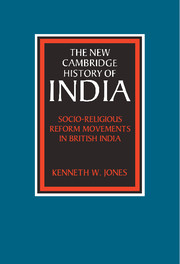Book contents
- Frontmatter
- 1 Concepts and context
- 2 Bengal and north-eastern India
- 3 The Gangetic core: Uttar Pradesh and Bihar
- 4 Punjab and the north-west
- 5 The central belt and Maharashtra
- 6 The Dravidian South
- 7 The twentieth century: socio-religious movements in a politicized world
- 8 Conclusion: religion in history
- Glossary of Indian terms
- Bibliographical essay
- Index
- THE NEW CAMBRIDGE HISTORY OF INDIA
- References
6 - The Dravidian South
Published online by Cambridge University Press: 28 March 2008
- Frontmatter
- 1 Concepts and context
- 2 Bengal and north-eastern India
- 3 The Gangetic core: Uttar Pradesh and Bihar
- 4 Punjab and the north-west
- 5 The central belt and Maharashtra
- 6 The Dravidian South
- 7 The twentieth century: socio-religious movements in a politicized world
- 8 Conclusion: religion in history
- Glossary of Indian terms
- Bibliographical essay
- Index
- THE NEW CAMBRIDGE HISTORY OF INDIA
- References
Summary
THE SETTING
The last regional chapter of this volume examines an area defined partly by geography, but more extensively by culture and language. The northern border of the Dravidian South begins on the east coast at the southern edge of Orissa, runs roughly along the northern lines of the Godavari River as it flows through the central Deccan, dipping south-west to Goa. The remainder of peninsular India extends to the southernmost tip of the mainland. Little exists in the way of geographically defined sub-areas within this region except for the thin western coast that continues from Maharashtra to the Cape. The rest of the peninsula is comprised of the Deccan plateau as it is narrowed by the convergence of the Western and Eastern Ghats to just above the Cape.
Each cultural and linguistic subdivision of the South radiates out from a core and blends into the others without clearly defined borders. The areas of each of the four languages — Telugu, Tamil, Kannada, and Malayalam — roughly correspond to the four southern states of India: Andhra Pradesh, Tamilnadu, Karnataka, and Kerala. Tamil is the oldest of the Dravidian languages with literature from the first century before Christ. The Tamil region was a second source of high culture pre-dated only by developments on the Indus and Gangetic plains. The three other Dravidian languages are considerably younger. The literature of Kannada dates from the tenth century, Telugu from the eleventh, and Malayalam from the thirteenth to fourteenth centuries. Each was influenced by Sanskrit and northern Brahmanical civilization, but still retained its own unique culture. A degree of unity exists between the four linguistic areas.
- Type
- Chapter
- Information
- Socio-Religious Reform Movements in British India , pp. 152 - 183Publisher: Cambridge University PressPrint publication year: 1990

